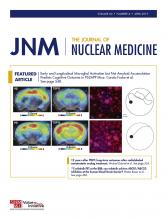TO THE EDITOR: To assess treatment response of bone metastases in breast cancer by PET/CT, Dr. Azad et al. recently compared the change in Ki (18F‐fluoride metabolic flux to bone mineral) with that in SUVmax and SUVmean (assessed with 40% of the SUVmax thresholding method) (1). Calculation of Ki in individual bone metastases was based on a semipopulation input function, which can be considered as a further development of the Hunter’s approach published for 18F-FDG, and whose equation of its “residual” part for 18F‐fluoride was, unfortunately, not provided (2). On the 18F‐fluoride PET/CT, the authors defined progressive disease (PD) as a 25% or more increase in Ki, SUVmax, or SUVmean, whereas non‐PD included partial responders (>25% decrease in Ki, SUVmax, or SUVmean) and stable disease (<25% increase or decrease). This classification was adapted from European Organization for Research and Treatment of Cancer criteria, with the acknowledgment that it was originally described for 18F‐FDG (3). The conclusion was that, after 8 wk of endocrine treatment for bone‐predominant metastatic breast cancer, Ki more reliably differentiated PD from non‐PD than SUVmax and SUVmean, probably because measurement of SUVs underestimates fluoride clearance as changes in input function are not accounted for.
We believe that using the same 25% or more increase to define PD (and, consequently, non-PD) for Ki as well as for both SUVmax and SUVmean should be questioned, since each of these quantitative parameters has its own measurement uncertainty (MU) (4). This issue is not related to the fact that the 25% threshold was originally described for 18F‐FDG and not 18F-fluoride, because MU of an arbitrary metrics is very likely close for several 18F-labeled tracers (5). In fact, MU of a quantitative parameter includes its repeatability, defined as the minimal relative change between 2 measurements assessed from 2 scans performed under changed conditions of measurement that is required to consider a significant difference (called “reproducibility” by the Joint Committee for Guides in Metrology (4)). This definition clearly highlights its relevance for assessing treatment response in solid tumors. The repeatability magnitude for SUVmax and SUVmean assessed with 40% of the SUVmax thresholding method may be estimated to be 19.6 and 13.8% (95% confidence level), respectively, from previously published studies performed in lung cancer patients with 18F-FDG, illustrating that averaging leads to lowering MU (6,7). In contrast, to the very best of our knowledge, the repeatability of Ki expressed in Equation 3 of the supplemental data by Azad et al. (1) remains unknown. However, one can ascertain that it is much greater than that of SUVmax or SUVmean, and even greater than 25%, because, besides sharing the MU of the tracer concentration in the bone region of interest with SUVmean, it additionally combines MU of the tracer concentration in the plasma, MU of the distribution volume in the unbound bone pool (arbitrarily set by the authors as that of a population mean value), and MU of the normalized time “Θ(T)” that requires adjusting the tracer release rate constant “kloss” (Supplemental Eq. 3 by Azad et al. (1)). In other words, whereas a 25% or more increase in SUVmax for defining PD and non-PD is consistent with SUVmax repeatability (about 19.6%), the same 25% value for Ki (whose repeatability is likely much greater than 25%) and for SUVmean (whose repeatability is about 13.8%) may not be appropriate. Finally, we would like to emphasize that the use of an average SUV, or a derived metrics, that can be obtained by pooling several hottest voxels possibly located in several separate places over the whole skeleton, by reducing repeatability, might thus be a relevant quantitative tool at the patient level for predicting response to treatment (8).
To conclude, Dr. Azad et al. relevantly put forward the interest of assessing treatment response of bone metastases in breast cancer by 18F-fluoride PET imaging. We further suggest that taking into account the repeatability of different metrics to define PD (and non-PD), rather than using the same percentage value of relative increase (or decrease), may prove of clinical value.
Footnotes
Published online Feb. 7, 2019.
- © 2019 by the Society of Nuclear Medicine and Molecular Imaging.







